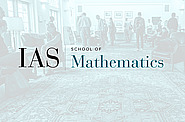Seminars Sorted by Series
Mini-Course in Geometric PDE
Oct
14
2008
Mini-Course in Geometric PDE
Fully Nonlinear Equations in Conformal Geometry
Matt Gursky
1:30pm|S-101
Oct
21
2008
Mini-Course in Geometric PDE
Variational Techniques for the Prescribed $Q$-Curvature Equation
1:30pm|S-101
Oct
28
2008
Mini-Course in Geometric PDE
Variational Techniques for the Prescribed $Q$-Curvature Equation
1:30pm|S-101
Nov
11
2008
Nov
18
2008
Jan
15
2009
Mini-Course in Geometric PDE
Issues in Homogenization for Problems with Nondivergence Structure
2:00pm|S-101
Jan
15
2009
Mini-Course in Geometric PDE
Issues in Homogenization for Problems with Nondivergence Structure
3:30pm|S-101
Jan
22
2009
Mini-Course in Geometric PDE
Issues in Homogenization for Problems with Nondivergence Structure
2:00pm|S-101
Jan
22
2009
Mini-Course in Geometric PDE
Issues in Homogenization for Problems with Nondivergence Structure
3:30pm|S-101
Mini-Course on Automorphy
Feb
24
2011
Feb
24
2011
Mar
03
2011
Mini-Course on Automorphy
Deformations of Galois Representations (continued)
David Geraghty
10:00am|S-101
Mar
10
2011
Mini-Course on Polyfolds
Mini-Symposium on Topology
May
01
2015
Mini-Symposium on Topology
Is the abstract mathematics of topology applicable to the real world?
Robert D. MacPherson; Randall D. Kamien; Raúl Rabadán
5:30pm|Wolfensohn Hall
Mini-Workshop on Kuranishi Structures and Gromov-Witten Moduli Spaces
Mar
06
2012
Mini-Workshop on Kuranishi Structures and Gromov-Witten Moduli Spaces
Kuranishi Structures and Gromov-Witten Moduli Spaces, Part I
10:00am|West Bldg. Lecture Hall
Mar
06
2012
Mini-Workshop on Kuranishi Structures and Gromov-Witten Moduli Spaces
Kuranishi Structures and Gromov-Witten Moduli Spaces, Part II
11:30am|West Bldg. Lecture Hall
Mar
07
2012
Mini-Workshop on Kuranishi Structures and Gromov-Witten Moduli Spaces
Kuranishi Structures and Gromov-Witten Moduli Spaces, Part III
9:30am|West Bldg. Lecture Hall
Mar
07
2012
Mini-Workshop on Kuranishi Structures and Gromov-Witten Moduli Spaces
Kuranishi Structures and Gromov-Witten Moduli Spaces, Part IV
11:00am|West Bldg. Lecture Hall
Moonshine Seminar
Oct
01
2020
Oct
08
2020
